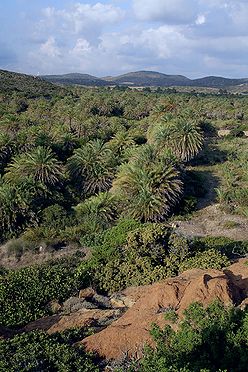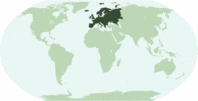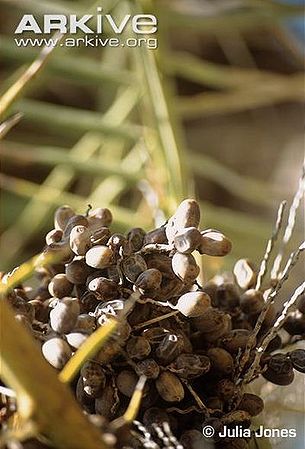Phoenix theophrasti
| Phoenix (FEH-niks) theophrasti (theh-OH-frahs-tee) | ||||||||
|---|---|---|---|---|---|---|---|---|
 Forest at Vai, Sitia, Greece. Photo by Tjaart Molenkamp | ||||||||
| Scientific Classification | ||||||||
| ||||||||
| Synonyms | ||||||||
|
| ||||||||
| Native Continent | ||||||||
|
| ||||||||
| Morphology | ||||||||
| ||||||||
| Culture | ||||||||
| ||||||||
| Survivability index | ||||||||
|
| ||||||||
| Common names | ||||||||
|
| ||||||||
Contents
Habitat and Distribution
East Aegean Is., Kriti, and Turkey.Sites on Crete include Vai in the Lasithi Prefecture, Ayios Nikitas in Heraklion Prefecture, and Preveli gorge and Souda near Plakias, both on the south coasts of Crete in Rethymnon Prefecture. Trees are also found on Amorgos island, and the south coast of Anafi island. Recently, around 10 trees, the only natural stand on the mainland, were found in an ancient palm forest in the Epidaurus area in Peloponnese. It has been proposed that, in Ancient Greece, there were many more, growing from Crete to Thebes, and from the Peloponnese to Delos. There are also four stands in southwest Turkey, especially on the Datça and Bodrum Peninsulas in Muğla Province. Areas forested with Phoenix theophrasti, Phoenix canariensis and Chamaerops humilis constitute Europe's only palm forests.
Native to southern Greece (Crete) and southwestern Turkey (Datça Peninsula). On Crete, there are eight subpopulations; the largest contains a few thousand individuals. Four subpopulations are known in Turkey.
Description
Clustering palm. Stem to 17 m tall, without leaf sheaths about 50 cm in diam., with leaves persistent in upper trunk, otherwise with persistent, diamond-shaped leaf bases. Leaves obliquely vertical in orientation, about 2 - 4 m long; leaf sheath fibrous, reddish-brown; pseudopetiole 50 - 70 cm long; acanthophylls irregularly arranged in more than one plane, to 10 on each side of rachis, yellow to orange-green; leaflets irregularly arranged in one to two planes of orientation, about 65 - 100 on each side of rachis, stiff, to 50 x 2 cm; lamina concolorous, glaucous, surfaces often white with waxy coating. Staminate inflorescences erect; prophyll coriaceous, splitting twice between margins, about 45 x 8 cm; peduncle to about 40 cm long; rachillae to about 10 cm long. Staminate flowers yellow-white, with strong musty scent; calyx cupule 2 - 3 mm high; petals 3 (rarely 4), 8 x 3.5 mm; stamens 6 (rarely 7). Pistillate inflorescences erect arching slightly with fruit maturity; prophyll to 50 x 6 cm; peduncle elongating on fruit set, to about 70 cm; rachillae to about 80 in number, elongating on fruit set, to about 50 cm long. Pistillate flowers yellow-white, with 3-lobed calyx cupule 2 - 2.5 mm high; petals 3 (rarely 4), 2 x 3 mm. Fruit oblong, about 15 x 10 mm, green-yellow to brown, with sparse, mealy, sweet mesocarp. Seed with rounded apices, 11 - 13 x 6 - 7 mm; embryo lateral opposite raphe; endosperm homogeneous. (S.C. Barrow. 1998)/Palmweb. Editing by edric.
| read more |
|---|
|
Phoenix theophrasti, the Cretan Date Palm, has been known in the Mediterranean since classical times when it was recorded by Theophrastus in Enquiry into Plants (370 - 285 BC, see Hort 1916) and Pliny in Natural History (see Rackham 1945). However, it was not until 1967 that the species was described formally by Greuter who named it in honour of the Greek botanist-philosopher. Phoenix theophrasti occupies a narrow ecological zone in coastal areas of southwestern Turkey and Crete, in habitats similar to those of feral dates: deep ravines, gorges, and water seepage areas. At present, the species is known only from Crete and southwestern Turkey, although Turland et al. (1993) reported 'P. theophrasti-like' palms from the East Aegean islands of Kalimnos, Nisiros and Simi. Phoenix dactylifera and P. theophrasti are easily confused, particularly when sterile, and thus new records of P. theophrasti must be treated with caution. Phoenix dactylifera and P. theophrasti are poorly differentiated and I consider the species status of P. theophrasti to be in doubt. Greuter (1967) considered the clustering habit of P. theophrasti to be a key character for differentiation of the species from P. dactylifera. Habit was earlier also referred to by Pliny who noted 'Some palms in Syria (referring to the area of modern Israel) and Egypt divide into two trunks, and in Crete even into three, and some even into five'. Similarly, Theophrastus (see Hort 1916) noted that '...they say that the palms in Crete more often than not have this double stem, and some of them have three stems; and that in Laporia one with five heads has been known.' Although P. theophrasti is a multiple-stemmed species, this character does not always distinguish it from P. dactylifera. In cultivation P. dactylifera exists as a single main stem with abundant basal suckers. These offshoots are generally removed for vegetative propagation purposes; however, if they are left to grow, a clump of many stems may arise from some date palm cultivars, just as with palms of P. theophrasti. All characters used to differentiate R dactylifera from other species in the genus must be considered in the context of the long history of P. dactylifera cultivation and human selection of certain morphological characteristics. Selection has focused particularly on such characters as peduncle length and fruit size, and thus they are not ideal for species differentiation. Phoenix dactylifera and P. theophrasti are difficult to differentiate on the basis of morphological and anatomical data such that the specific status of the latter species is debatable. Furthermore, molecular data supports the two species as close sisters. An extensive range of morphological variation is exhibited by P. dactylifera, and it is likely that the morphological charateristics of P. theophrasti fall within this range. Although this study comes close to considering the two species conspecific there is still, in my opinion, insufficient data to support such a decision. This problematic issue can only be resolved by an extensive morphological survey of P. dactylifera across its geographical range, and the morphological characteristics of the feral date palms of the Persian Gulf, in particular, must be clarified. If P. theophrasti is found to be very similar to the Persian date palms then I would consider it undoubtedly a synonym of P. dactylifera. Even if this is indeed proven to be so, there may still be a case for maintaining the name P. theophrasti to refer to non-cultivated, feral populations of palms occupying wild habitats. Populations of palms in Turkey, Crete and areas of the Near East (and possibly elsewhere) would then be referrable to P. theophrasti. (S.C. Barrow. 1998)/Palmweb. |
Culture
Comments and Curiosities
Similar to Phoenix dactylifera in overall appearance but usually shorter, not over 15 m tall. The fruit is a small date with only a thin, sour-tasting flesh layer around the seed.
Uses: In Crete leaves of R theophrasti are used in Palm Sunday celebrations, just as leaves of P. dactylifera are used elsewhere. (S.C. Barrow. 1998)/Palmweb.
"In Seattle these are susceptable to rot, so don't water them too much in winter, but in summer you can. They have edible dates too." (Kyle Wicomb)
Conservation: IUCN ReadList - Lower Risk/near threatened. 1998. On Crete, there are eight sub-populations; the largest contains a few thousand individuals. Four subpopulations are known in Turkey.
"Probably THE original date palm from which Phoenix dactylifera, the edible date, was derived from. It is native to the coasts of Turkey and Crete and looks a lot like a date palm. The main differences is it has a bit more color in the spines and it much spinier, nastier palm (be very careful around this one)-every single leaf ends in a very sharp, stiff barb. In my opinion, this is one of the most dangerous palms there are. The other difference I have noticed is this one is a super aggressive clumper-makes LOTS of suckers and is a constant chore (and a very dangerous one) to keep the suckers down to a minimum. Don't recommend leaving all the suckers or you will eventually have a massive, tightly spaced grove of deadly sharp, impenetrable palm trees. Very drought, wind and heat tolerant." (Geoff Stein)
- IMAGE GALLERY
"This is (or was: see the same tree in March 2009) probably the largest individual of the Cretan palm in Crete. There are two levels of suckers surrounding the main trunk, which is about 10 m tall. There may perhaps be larger ones in SW Turkey." Vaï, Crete, Greece. spring 1988. Photo by Nick Turland.
External Links
- Glossary of Palm Terms
- MODERN BOTANICAL LATIN
- "Just To Be Clear"
- http://www.flowersofcrete.info/Cretanpalm.html
- http://cretaplant.biol.uoa.gr/pamphlet/Phoenix-pamphlet-en.pdf
- http://www.youtube.com/watch?v=2NGXsWYYn9o
References
Phonetic spelling of Latin names by edric.
Special thanks to Geoff Stein, (Palmbob) for his hundreds of photos.
Special thanks to Palmweb.org, Dr. John Dransfield, Dr. Bill Baker & team, for their volumes of information and photos.
Glossary of Palm Terms; Based on the glossary in Dransfield, J., N.W. Uhl, C.B. Asmussen-Lange, W.J. Baker, M.M. Harley & C.E. Lewis. 2008. Genera Palmarum - Evolution and Classification of the Palms. Royal Botanic Gardens, Kew. All images copyright of the artists and photographers (see images for credits).
S.C. Barrow, A Monograph of Phoenix L. (Palmae: Coryphoideae). 1998. A Monograph of Phoenix L. (Palmae: Coryphoideae). Kew Bulletin, Vol. 53, No. 3 (1998), pp. 513-575.
Many Special Thanks to Ed Vaile for his long hours of tireless editing and numerous contributions.




































































































































